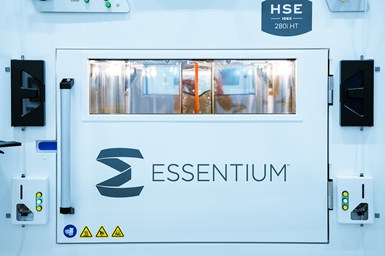Essentium Printer Features Independent Dual Extrusion System
The company is also introducing Essentium PP-CF, a new high-performance material for chemically resistant and low surface energy AM parts.

Essentium’s High Speed Extrusion (HSE) 280i HT 3D Printer enables manufacturers to reduce the time for reaching industrial-scale production of parts.
Essentium is launching the High Speed Extrusion (HSE) 280i HT 3D Printer, which the company says is the first true independent dual extrusion system (IDEX) designed and developed for the demands of the factory floor. The company is also introducing Essentium PP-CF, a new high-performance material for chemically resistant and low surface energy additive manufacturing (AM) parts.
The HSE 280i HT 3D printer features true independent dual extruders, whereby each head is fully independent on both the X- and Y-axis. This enables manufacturers to reduce the time for reaching industrial-scale production of parts, even for complex geometric shapes, while significantly reducing postprocessing costs.
The HSE 280i HT 3D Printer is said to deliver world-class print speeds of more than 500 mm/sec., which is five to 15X faster than competitive offerings, by utilizing a non-slip, high-torque extrusion system with all linear servomotors. Differing from most fused filament fabrication (FFF) processes that rely on a heated build chamber, the HSE 280i HT 3D Printer uses a multimodal heating method designed to heat the part, eliminating the need for manufacturers to wait for the chamber to heat up to start printing.
The HSE 280i HT 3D Printer is built to transform manufacturing floors and solve the AM issues of speed, strength and scale, which have held back the shift from prototyping to full-scale production.
Developed in partnership with LEHVOSS Group, Essentium PP-CF is a 20% carbon fiber reinforced polypropylene filament made with Luvocom 3F resin from LEHVOSS. This material is designed to deliver excellent mechanical performance combined with outstanding printability. The company says it offers excellent chemical resistance and low surface energy, making it useful for silicone and urethane molding applications. This material enables manufacturers to print chemically resistant, low surface energy parts with greater strength and stiffness than unreinforced polyolefins.
Related Content
-
3D Printed Seal for Geothermal Power: The Cool Parts Show #73
Plugging a hole is a complex challenge when it’s a well for geothermal power. Additive manufacturing produces a shape-changing stainless steel seal for high-temperature applications deep underground.
-
BPMI Chooses Velo3D Metal 3D Printing System to Produce Parts for U.S. Naval Nuclear Propulsion Program
The fully integrated 3D printing solution will be operated by ATI in a newly established facility that will provide the U.S. Naval Nuclear Propulsion Program with alternatives to cast parts.
-
Video: AM for Repair of Large Shafts
Wind power shafts that might once have been scrapped are now returned to service. See the robotic directed energy deposition (DED) and shaft preheating system developed by Ikergune, Izadi and Talens.













